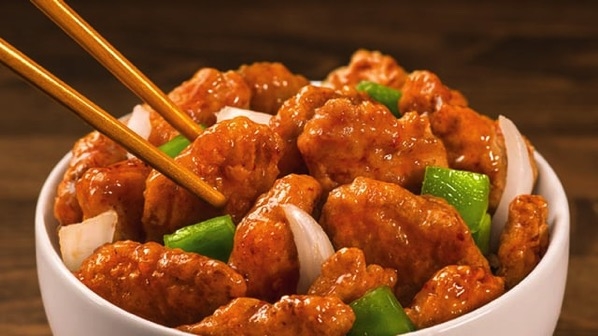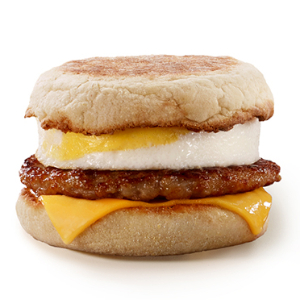Yesterday, we looked at some of the myths and legends surrounding Pork, and why it is shunned by certain portions of the population. Today, as promised, we look at some more-practical aspects of its preparation and handling. Welcome (back) to the joys of ‘the other white meat’…
 Panda Express Peking Pork: Boneless, flavourful, moist and tender…
Panda Express Peking Pork: Boneless, flavourful, moist and tender…
Remember back when Beef and other ‘Red’ meats were first condemned as dietarily dangerous because of their cholesterol content? and Pork producers – carefully treading a line in the sand – launched massive ‘Pork: The Other White Meat’ promo campaign to encourage consumers to mentally position their product with poultry and seafood on the ‘safe’ side of the cholesterol ‘line’? They were fairly successful.
Stopped beating the drum
But, then, they stopped beating their drum and Pork sales coasted. And retail Pork promos thereafter more or less jumped on the specialty cuts bandwagon, with a concentration on Sausages and Ribs. You saw a rise in the number of restaurants putting Pork Ribs on their menus, and adding it in various guises to Tex-Mex bills of fare. One niche in which they did advertise relatively intensively was the Bacon and other cured meats sector. Burger and other Fast Food joints started putting Bacon Strips on all kinds of main-menu dishes (mainly sandwiches). Sausage Patties, too, became a big deals in the producers’ overall sales picture as just about everybody in the Fast Food sector instituted breakfast, and then ‘All-Day’ breakfast service.
One saving grace for Pork producers was that North America became a net exporter of Pork and Pork products over the last few decades, selling incredible amounts to European and especially Asian countries. They didn’t have to count on domestic sales to ensure their success and, so, let their attention to the home market lapse.
And supermarket sales suffered
In the 1990s and early 2000s, new generations of grownups’ started living independently from their parents, doing their own food shopping, and largely forgot about Pork. Now, pork producers find themselves in the unenviable tradition having to go back to the beginning and reestablish Pork as a lean, tasty, tender and juicy real meat option.
And I felt it was a good time to review Pork’s merits and advantages…
Merits and advantages
Yesterday, we introduced the notion that many of the reasons folks today shun Pork are driven by misunderstandings that have re-emerged since ‘Other White Meat’ campaign concluded. Today, I’d like to address some major misconceptions about Pork prep and cooking.
Legend: Pork is tough
It’s all in the way you prepare and cook it. Some will point out that Marination is a great approach to ensure more-tender Pork. Your Pork marinade should contain fresh (not pasteurized or cooked) Pineapple or Papaya Juice. Get it almost any day at the fresh-squeezed Juice kiosk in your supermarket’s Deli section. These juices contain papayin, a natural compound that helps tenderize lean meats. White Wine can also help, but is not nearly as effective a treatment. And marination is a fabulous way to add flavour to Pork. (See ‘Bland’, below.)
Not a popular practice these days, Pounding the meat with a meat hammer is a great way to separate the fibres of lean, fine-grained Pork before cooking. It also lets moisture into the meat. Pork Chops pounded out to cutlets are light, moist and fork-tender. More on that when we look at some recipes later in the week…
Legend: Pork is Dry
Nonsense. See ‘Marination’, above, for a start. The commercial processors and the Deli pros actually needle-inject moisture into meats to keep them moist and help tenderize and flavour them. Basting is also employed to keep meat moist during long, slow cooking as well as adding flavour.
And remember that Fat is a player in making meat moist. I’ll just mention that the fat cap is almost always kept on larger cuts of Pork, such as Butt (shoulder) roasts, to baste the meat during cooking and keep moisture in.
Legend: Pork is excessively fatty
Ridiculous! It’s actually naturally lean. The fat is almost all on the outside of the roasts and chops we mainly consume. That’s why we have developed so many techniques and options for adding and keeping it moist. Pork is a meat that that is often wrapped in a layer of added fat to keep moisture in and add flavour. That extra fat is customarily discarded after cooking. If it’s Bacon, it’s usually left on. But most of the fat that Pork starts with before cooking is actually rendered off and left behind before serving.
Legend: Pork is bland
Utter nonsense! Like Chicken, Pork is a great cooperator in the sharing and blending of flavours. And that rare quality is taken advantage of a lot in Smoking and BBQing. Pork is also prized traditionally in Mexican and Tex cuisine for the same reason. It’s own unique, umami-rich flavour never intrudes too much on added essences that distinguish spicy, boldly flavoured recipes from each other.
Back in another few days with those recipes we talked about, which are being carefully chosen to illustrate the points I’ve made above…
~ Maggie J.

